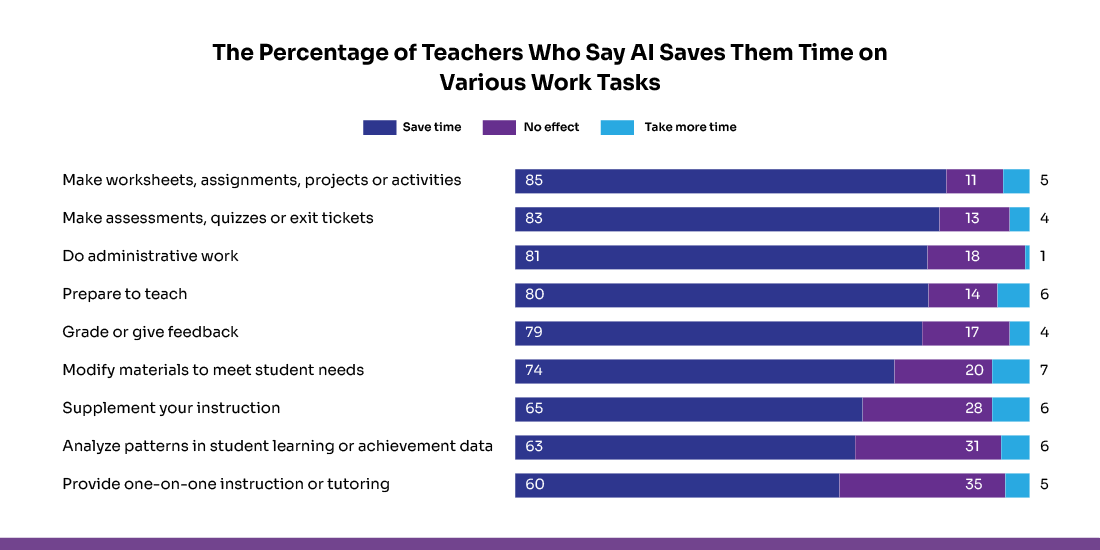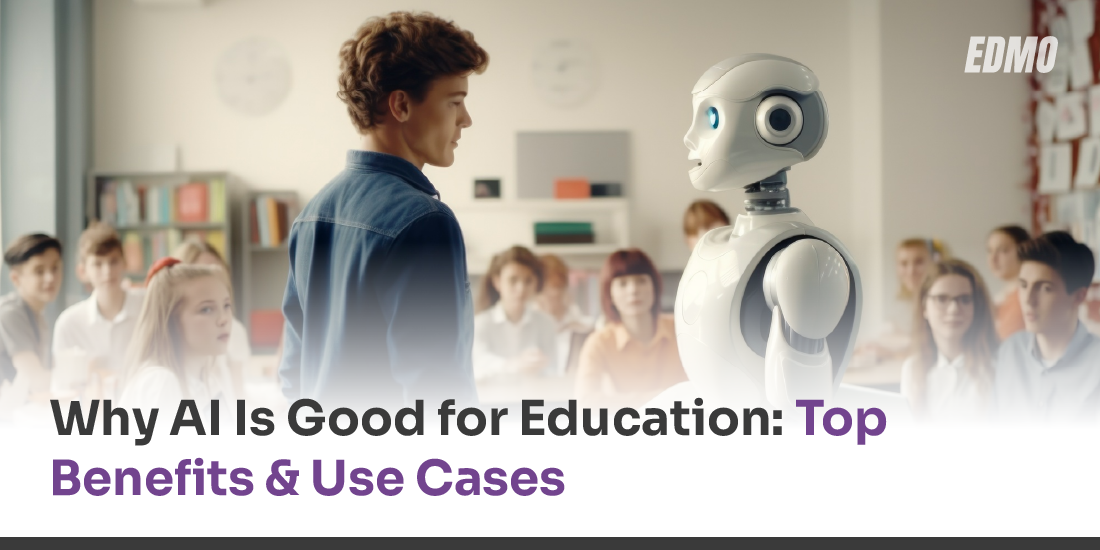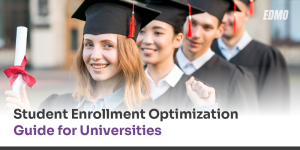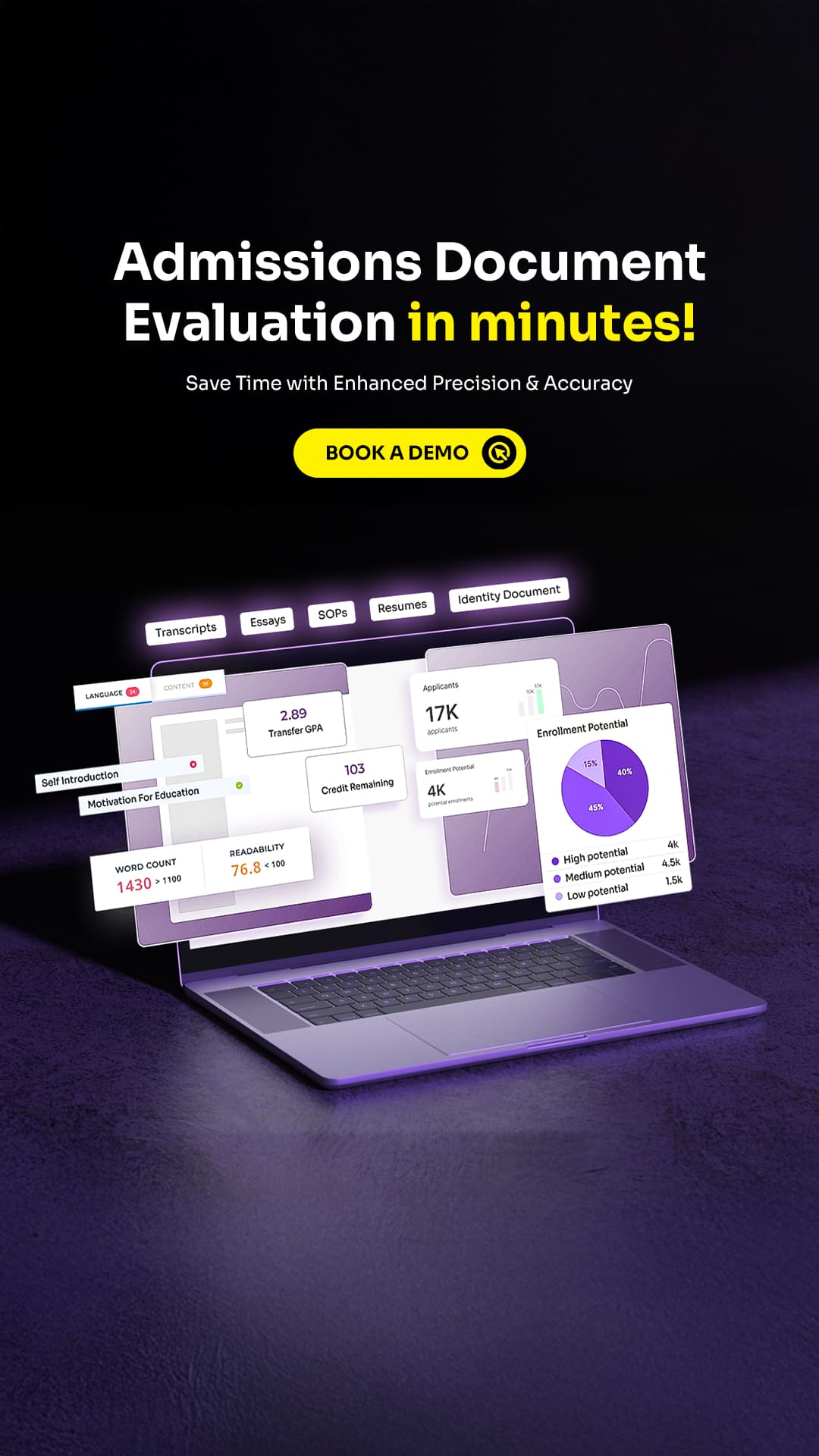Table Of Contents
Introduction
Artificial intelligence is reshaping the way students learn and how institutions operate, making education smarter, faster, and more personalized. If you’re wondering why AI is good for education, the answer lies in its ability to adapt learning to each student, reduce teacher workload, improve decision-making, and create more equitable opportunities. From AI-powered tutoring systems to predictive analytics in admissions, today’s technology is transforming classrooms and campuses worldwide. In this blog, we explore the top benefits of AI in education and the most impactful use cases that are already changing the future of learning.
Major Advantages of Integrating AI in Education
Understanding why AI is good for education starts with exploring the key advantages it brings to both students and educators. From personalized learning to smarter decision-making, AI enhances the entire academic ecosystem and makes learning more efficient, accessible, and future-ready.
Personalized Learning Experience
AI enables educators to create deeply personalized learning pathways by analyzing each student’s pace, strengths, and improvement areas. This ensures learners get the right level of challenge and support at every step. The result is faster mastery and more engagement. According to recent surveys, 60% of teachers now use AI daily, mainly to deliver personalized instruction.

Source: Whatsthebigdata
Greater Administrative Efficiency
AI significantly cuts down the time teachers spend on repetitive tasks such as grading, attendance tracking, scheduling, and organizing student data. By automating these processes, schools can improve productivity and allow educators to dedicate more time to student support and lesson planning. A Gallup report shows that three in 10 teachers now use AI every week, helping them save nearly six weeks of work time each school year, which directly enhances overall teaching quality and efficiency. With EDMO’s Document Intelligence, institutions can automate complex document workflows, eliminate manual data entry, and ensure faster, error-free processing.

Source: Gallup
Improved Accessibility and Inclusivity
AI-powered tools make education more accessible by offering multilingual content, assistive technologies, and flexible learning resources. These features especially support students with disabilities, remote learners, and underserved communities. By reducing learning barriers, AI ensures equitable access to quality education for all.
Real-Time Assessment and Feedback
AI systems track performance continuously and deliver instant, actionable feedback that helps students improve faster. This early insight allows learners to close gaps and adjust their study approach effectively. Educators also benefit from accurate progress data to guide their teaching strategies. At St Mary MacKillop College, using an AI writing-feedback tool led to a 47% improvement in final responses, with over 90% of teachers reporting better learning outcomes.
How to Use Artificial Intelligence in Education Wisely
Understanding why AI is good for education is only the first step—using it wisely is what delivers real impact. When integrated thoughtfully, AI can transform learning, but experts emphasize the need for strategic, ethical, and well-planned adoption. Below are the key pillars that support responsible and effective use of AI in education.
Invest in Training Educators
For AI to enhance learning effectively, teachers must be equipped with the right skills. This includes:
- Understanding how various AI tools work
- Knowing how to align AI capabilities with learners’ needs
- Developing confidence to integrate AI into daily teaching
When educators are well trained, they can use AI for personalized instruction, quicker assessments, and stronger classroom support. A November 2025 survey shows this shift clearly 50% of teachers received AI-related professional development, a major increase from just 13% in 2023.
Maintain a Balanced Approach
AI should support, not replace, human teaching. A balanced strategy ensures that:
- Traditional teaching methods continue to build interpersonal, critical thinking, and emotional skills
- AI tools are used where they add meaningful value—such as automating tasks or providing adaptive practice
- Students still benefit from human guidance, empathy, and mentorship
Students still rely on human guidance, empathy, and mentorship for meaningful growth. In the UK, 83% of teachers say AI saves them time, and 88% of frequent users report a workload reduction of up to 5 hours per week.
Prioritize Ethics and Data Privacy
As AI systems rely on large volumes of student data, institutions must:
- Strengthen data protection policies
- Ensure AI tools comply with privacy regulations
- Use AI transparently to maintain trust
- Teach students responsible AI use
Ethical implementation safeguards learners and promotes responsible digital citizenship.
Commit to Continuous Review and Improvement
AI technologies evolve rapidly. To ensure long-term benefits, institutions should:
- Regularly evaluate the performance of AI tools
- Ensure they continue to meet academic objectives
- Update or replace outdated systems
- Monitor student outcomes to identify improvements
Academics often refer to this practice as “Keeping the Ax Sharp”—fine-tuning tools and strategies to maximize their impact over time.
39 Powerful Applications of Artificial Intelligence in Modern Education
Artificial intelligence is reshaping the education landscape with innovative tools that elevate teaching, personalize learning, and streamline operations. From adaptive platforms to automated administration, here are 39 impactful ways AI is transforming education today:
Adaptive Learning
AI-driven platforms track student performance in real time and automatically adjust lessons to match each learner’s pace and needs. This creates personalized learning paths that help students strengthen weak areas and progress more confidently. According to a RAND report, 61% of teachers use adaptive learning systems at least once a week, showing how widely these tools are being adopted.
Assistive Technologies
Speech recognition, text-to-speech, and other AI tools enhance accessibility for students with disabilities, enabling smoother participation for learners with dyslexia, hearing impairments, and other challenges.
Learning & Data Analytics
AI analyzes attendance records, learning behaviors, and academic performance to uncover patterns and predict student outcomes. These insights help educators identify struggling learners early and provide timely interventions. As a result, institutions can make more informed decisions that improve overall student success.
Classroom Management
AI tools help improve classroom engagement by gamifying behavior tracking and participation. Students receive rewards for positive actions, while teachers gain real-time insights into classroom dynamics. This allows educators to manage interactions more effectively and create a more engaging learning environment.
Intelligent Tutoring Systems
AI-powered tutoring platforms, such as Carnegie Learning, offer personalized, real-time support tailored to each student’s learning style. These systems provide targeted explanations, adaptive practice, and step-by-step guidance on complex topics. This ensures students get individualized help even outside classroom hours.
Automated Grading and Feedback
AI streamlines the grading process by evaluating quizzes, assignments, and essays quickly and consistently. Students receive instant, high-quality feedback, while teachers save valuable time on repetitive tasks. A Stanford study found that just 2–5 hours of student interaction data from intelligent tutoring systems can reliably predict long-term academic outcomes, such as end-of-year performance.
Chatbots and Virtual Assistants
AI-powered chatbots provide instant answers to student questions, send reminders, and guide learners through administrative steps—all available 24/7. Their impact is significant Bakersfield College’s virtual assistant has handled over 424,000 student queries, saving more than $2.2 million in staff time and drastically reducing email volume. Tools like these use AI and predictive analytics to support student success at scale.
Curriculum Design Support
AI helps educators design stronger curricula by analyzing learning trends, student performance data, and skill requirements. This ensures that academic programs stay updated, relevant, and aligned with current industry and educational standards.
Intelligent Learning Games
AI-powered learning games adapt challenges in real time based on how students respond. By adjusting difficulty and pacing, these tools improve engagement, build deeper understanding, and make learning more interactive and enjoyable.
Personalized Learning Paths
AI customizes instruction by analyzing each student’s pace, preferences, and learning style. This reduces cognitive overload, ensures students receive the right level of guidance, and helps them achieve better learning outcomes.
Task Automation
AI automates repetitive academic duties such as grading, report generation, and test creation. This significantly reduces teacher workload, enhances accuracy, and allows educators to focus more on student interaction and instructional quality.
Smart Content Creation
AI help teachers quickly build high-quality instructional materials, including interactive lessons, assessments, and IEPs. These platforms save time, enhance creativity, and ensure that learning content is more engaging and aligned with student needs.
AI-Based Proctoring
AI-powered proctoring systems monitor online exams for irregular or suspicious behavior, using features like facial recognition and activity detection. This ensures a fair testing environment, maintains academic integrity, and reduces the need for manual supervision during remote assessments.
Language Learning Enhancement
Language-learning platforms like Duolingo use AI to personalize lessons, adjust difficulty levels, and track learner progress. This adaptive approach improves retention, boosts student engagement, and helps students master new languages more effectively.
Skill Gap Identification
AI analyzes student performance data to identify missing skills or knowledge gaps. It then recommends targeted resources, practice exercises, or support strategies to help learners improve. This enables more accurate and effective academic intervention.
Dyslexia & Learning Disorder Detection
AI tools like Dysolve analyze reading patterns to identify early signs of dyslexia and other learning disorders. This early detection allows educators and parents to provide timely intervention, personalized support, and targeted learning strategies to help students succeed.
Gamification
AI enhances learning by integrating interactive quizzes, simulations, and challenge-based activities that make education feel more like a game. This approach boosts motivation and participation. According to TeachNG, 67% of U.S. students prefer gamified learning because they find it more engaging than traditional coursework.
Administrative Automation
AI streamlines institutional operations by automating scheduling, budgeting, HR processes, and resource allocation. This reduces administrative workload, improves accuracy, and enables schools to operate more efficiently.
Virtual 3D Classrooms
Platforms such as Engage VR create immersive, 3D learning environments where students can collaborate, experiment, and explore virtual simulations. These metaverse-based classrooms offer a more interactive and engaging alternative to traditional online learning.
Enhanced Digital Learning
AI elevates digital lessons by adding features like simulations, instant feedback, and adaptive content through tools like Nearpod. This makes online learning more interactive, personalized, and effective for students at all levels.
Virtual Student Activities
AI supports extracurricular engagement by enabling virtual clubs, events, and student communities. These interactive digital spaces encourage collaboration, creativity, and participation beyond the classroom.
Interdisciplinary Learning Tools
AI-powered platforms like Wolfram Alpha help students connect concepts across different subjects by demonstrating real-world applications. This encourages cross-disciplinary thinking and supports deeper, more integrated learning.
Real-Life Scenario Simulations
Tools such as Labster create virtual simulations of real-world labs and environments, allowing students to gain practical, hands-on experience safely. These simulations help learners understand complex processes without the limitations of physical resources.
Global Awareness & Social Learning
AI tools like EarthSpeakr expose students to global challenges and social issues, helping them develop critical thinking and a sense of responsibility. These tools foster cultural awareness and encourage meaningful discussions about worldwide concerns.
AI-Powered Virtual Tours
Platforms such as Google Expeditions offer immersive virtual field trips and campus tours, expanding students’ exposure beyond the classroom. These AI-enhanced tours make global exploration accessible to all learners.
Guest Lectures & Virtual Events
AI-enabled systems like BigMarker help institutions host virtual conferences, expert talks, and global classroom events. At Empire State University, AI-driven tools increased virtual self-service usage by 234% and improved year-over-year student retention by 3.7%, demonstrating their impact on engagement and learning outcomes.
Predictive Analytics for Learning
AI examines student behavior, academic patterns, and performance trends to identify those who may be at risk. By detecting early warning signs, educators can provide timely support, personalized interventions, and targeted resources. This proactive approach helps improve retention and academic success.
Parent-Teacher Communication
AI tools like Remind simplify communication by sending instant updates, alerts, and reminders to families. This real-time connection keeps parents informed about student progress, attendance, and important announcements. As a result, engagement improves and the home–school relationship becomes stronger.
Test Preparation Assistance
AI-powered platforms such as Magoosh tailor study plans by analyzing student performance and adjusting practice questions to their level. This adaptive approach helps learners focus on weak areas, improve accuracy, and prepare more efficiently for exams. It creates a more effective and personalized test prep experience.
AI-Enhanced Learning Management Systems (LMS)
Modern LMS platforms now integrate AI to offer customized learning paths, automate routine tasks, and provide deeper insights into student engagement. These intelligent features help educators monitor progress more easily and allow students to learn at their own pace. AI-enhanced LMS systems create a more streamlined and effective digital learning environment.
AI in Professional Development
AI-driven platforms support teachers by offering personalized training recommendations, skill-building resources, and career development guidance. These tools help educators stay updated with new teaching strategies and technologies.
Transportation Optimization
AI-powered systems like SafeStop optimize school transportation by mapping efficient bus routes, reducing travel time, and enhancing student safety through real-time GPS tracking and alerts.
Financial Management
AI tools such as Allovue help schools make smarter financial decisions by analyzing spending patterns, forecasting budget needs, and ensuring funds are allocated effectively across programs.
Cybersecurity Protection
Advanced AI solutions like Darktrace continuously monitor network behavior to detect anomalies, prevent cyberattacks, and safeguard sensitive student and institutional data.
Campus Safety & Surveillance
AI-driven surveillance platforms like Avigilon improve campus safety by monitoring real-time video feeds, identifying potential threats, and instantly notifying security teams.
Plagiarism Detection
AI systems scan millions of academic papers and online sources to detect similarities, helping institutions maintain academic integrity and prevent plagiarism more accurately.
Enhanced Online Discussion Forums
Platforms such as Packback use AI to moderate conversations, guide discussion quality, and encourage deeper critical thinking, making online learning more interactive and engaging.
Academic Research Support
AI-powered research engines like IBM Watson Discovery can quickly analyze large and complex datasets, uncover patterns, and generate meaningful insights, helping researchers accelerate discoveries and improve the quality of academic work.
Connected Smart Campuses
AI-enabled platforms such as Cisco DNA unify campus systems—including Wi-Fi networks, security infrastructure, and operational tools—into an intelligent, interconnected ecosystem that enhances efficiency, safety, and overall campus management.
What AI Means for the Future of Learning and Admissions
AI is set to transform how students learn and how institutions manage admissions. By enabling personalized learning, automating complex processes, and using data-driven predictions, AI is creating a more efficient, transparent, and student-centric education system.
Personalized Learning Experiences
AI allows institutions to tailor learning to the individual. Adaptive learning platforms continuously analyze student performance, identify gaps, and adjust content to suit each learner’s pace and style. This not only improves engagement but also ensures that students master concepts more efficiently.
Smarter Admissions and Enrollment
AI-powered predictive analytics help institutions forecast application trends, identify strong applicants, and even evaluate the probability of student success. By leveraging these insights, admissions teams can make more accurate decisions, refine enrollment strategies, and strengthen overall retention. More than 75% of higher-education administrators believe that the use of AI-driven enrollment and success models will continue to grow in the coming years. With EDMO’s Conversation Intelligence, institutions gain deeper insights from student interactions, improving conversion at every stage of the enrollment funnel.
Enhanced Student Support
AI-powered chatbots, virtual assistants, and smart advising systems now deliver 24/7 guidance to students. These tools can instantly answer questions, recommend suitable courses, send reminders, and help learners make informed decisions with ease. At Bethel University, the introduction of an AI chatbot led to a 7% increase in student retention, resulting in substantial financial benefits for the institution.
Reducing Bias and Promoting Equity
AI can play a crucial role in minimizing unconscious bias in admissions by evaluating applicants through holistic, data-driven insights rather than subjective judgment. It also supports equity by offering personalized learning resources and targeted interventions for underrepresented or at-risk students. In a survey of 342 U.S. college counselors, 80% agreed that AI and ed-tech have the potential to significantly improve fairness and equity in the admissions process.
Future-Ready Skills Development
Integrating AI into the curriculum equips students with practical experience in emerging technologies, helping them build essential skills in areas like AI, data analytics, and other tech-driven fields. This approach ensures learning remains both personalized and aligned with the demands of the modern workforce. Recent reports show that 50% of higher-education students view AI literacy as critical for their future careers, while 62% stress the importance of understanding responsible AI use.
Conclusion
Understanding the many reasons why AI is good for education helps institutions, teachers, and students embrace technology with confidence. From personalized learning and data-driven insights to automation and improved student support, AI is transforming every stage of the academic journey. As schools and universities adopt smarter tools, the benefits become even clearer—greater efficiency, reduced bias, and better outcomes for all learners.
By recognizing why AI is good for education, institutions can make informed decisions that enhance teaching quality, elevate student experiences, and prepare learners for a tech-driven future.








No comments yet. Be the first to comment!
Leave a Comment